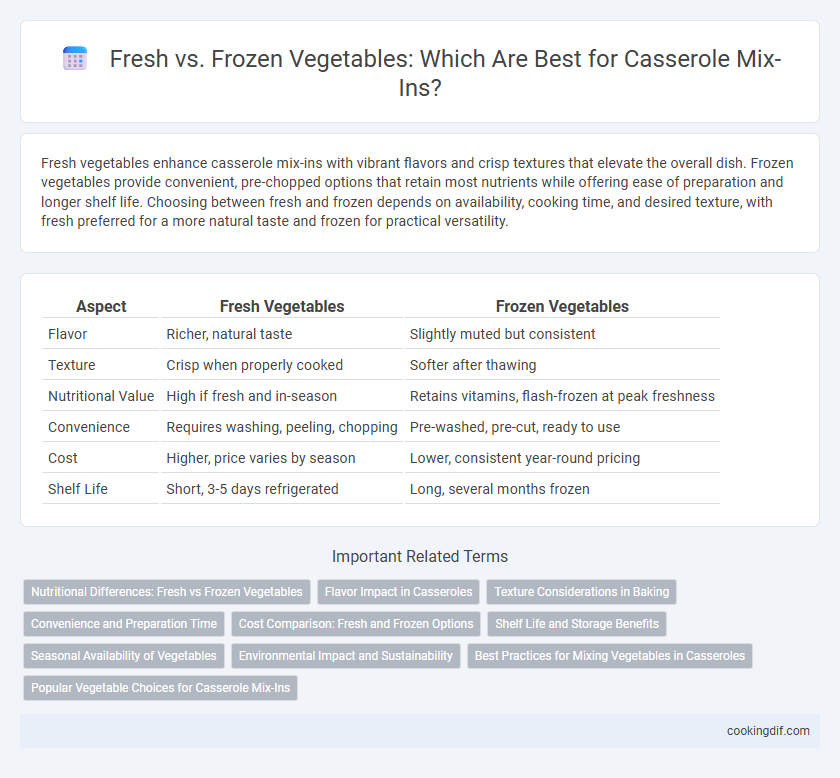Fresh vegetables enhance casserole mix-ins with vibrant flavors and crisp textures that elevate the overall dish. Frozen vegetables provide convenient, pre-chopped options that retain most nutrients while offering ease of preparation and longer shelf life. Choosing between fresh and frozen depends on availability, cooking time, and desired texture, with fresh preferred for a more natural taste and frozen for practical versatility.
Table of Comparison
| Aspect | Fresh Vegetables | Frozen Vegetables |
|---|---|---|
| Flavor | Richer, natural taste | Slightly muted but consistent |
| Texture | Crisp when properly cooked | Softer after thawing |
| Nutritional Value | High if fresh and in-season | Retains vitamins, flash-frozen at peak freshness |
| Convenience | Requires washing, peeling, chopping | Pre-washed, pre-cut, ready to use |
| Cost | Higher, price varies by season | Lower, consistent year-round pricing |
| Shelf Life | Short, 3-5 days refrigerated | Long, several months frozen |
Nutritional Differences: Fresh vs Frozen Vegetables
Fresh vegetables offer higher vitamin C levels and slightly better antioxidant profiles compared to frozen, which may experience nutrient loss during blanching before freezing. Frozen vegetables retain most minerals and fiber content, providing a convenient and nutrient-dense option for casserole mix-ins. Choosing between fresh and frozen often depends on seasonality, availability, and convenience rather than significant nutritional differences.
Flavor Impact in Casseroles
Fresh vegetables deliver vibrant, natural flavors that intensify during cooking, enhancing the overall taste profile of casseroles. Frozen vegetables often retain key nutrients but may release excess water when heated, potentially diluting flavors and altering texture. Selecting fresh vegetables ensures a richer, more robust flavor impact and a balanced, satisfying mouthfeel in casserole dishes.
Texture Considerations in Baking
Fresh vegetables deliver a crisp texture and vibrant flavor to casseroles, maintaining their firmness during baking. Frozen vegetables tend to release more moisture, which can lead to a softer, sometimes mushier texture in the final dish. To achieve the ideal casserole texture, drain and pat frozen vegetables dry before mixing to reduce excess water content.
Convenience and Preparation Time
Fresh vegetables provide a richer flavor and firmer texture for casserole mix-ins but require washing, chopping, and longer prep time. Frozen vegetables offer unmatched convenience, coming pre-cut and ready to use, significantly reducing preparation time while retaining most nutrients. Choosing frozen mix-ins can streamline cooking without compromising the overall quality of the casserole.
Cost Comparison: Fresh and Frozen Options
Fresh vegetables for casserole mix-ins often carry a higher upfront cost, especially out of season, due to factors like transportation and spoilage. Frozen vegetables provide a budget-friendly alternative with comparable nutritional value, as they are typically flash-frozen at peak ripeness, reducing waste and extending shelf life. Choosing frozen options can significantly lower grocery expenses while maintaining quality in casserole preparations.
Shelf Life and Storage Benefits
Fresh vegetables for casserole mix-ins offer superior texture and flavor but have a limited shelf life of approximately 3 to 7 days when stored properly in the refrigerator. Frozen vegetables provide extended shelf life ranging from 8 to 12 months in the freezer, reducing food waste and allowing for convenient meal prep. The freezing process preserves nutrients and minimizes spoilage, making frozen vegetables a practical choice for long-term storage and consistent casserole quality.
Seasonal Availability of Vegetables
Seasonal availability significantly influences the choice between fresh and frozen vegetables for casserole mix-ins, as fresh vegetables are often harvested at peak ripeness, offering superior flavor and texture during their natural growing seasons. Frozen vegetables provide a convenient, year-round option, preserving nutrients and freshness shortly after harvest through flash-freezing, maintaining quality even when specific vegetables are out of season. Selecting vegetables based on seasonality can enhance the overall taste and nutritional value of casseroles while supporting sustainable consumption patterns.
Environmental Impact and Sustainability
Fresh vegetables for casserole mix-ins often have a lower carbon footprint when sourced locally and seasonally, reducing transportation emissions and supporting sustainable farming practices. Frozen vegetables, while sometimes associated with higher energy use in processing and storage, can reduce food waste due to longer shelf life and are often frozen at peak ripeness, preserving nutrients. Choosing between fresh and frozen vegetables depends on factors such as sourcing, packaging, and storage efficiency, which collectively influence the environmental impact and sustainability of casserole ingredients.
Best Practices for Mixing Vegetables in Casseroles
Fresh vegetables provide vibrant flavor and texture when mixed into casseroles but require thorough washing and uniform chopping for even cooking. Frozen vegetables offer convenience and consistent quality, often pre-blanched to preserve nutrients and reduce moisture release during baking. Combining both fresh and frozen vegetables requires careful timing and layering to avoid sogginess and ensure evenly cooked, flavorful casserole outcomes.
Popular Vegetable Choices for Casserole Mix-Ins
Fresh vegetables like bell peppers, zucchini, and green beans are popular for casserole mix-ins due to their vibrant flavor and crisp texture. Frozen vegetables such as peas, corn, and spinach provide convenience and consistent quality while retaining essential nutrients. Selecting a combination of fresh and frozen vegetables can enhance texture variety and ensure year-round availability for casseroles.
Fresh vs frozen vegetables for casserole mix-ins Infographic

 cookingdif.com
cookingdif.com